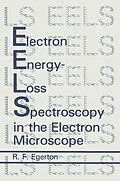Electron energy-loss spectroscopy (EELS or ELS) has been used to investi gate the physical properties of solids for over 40 years in a handful of laboratories distributed around the world. More recently, electron micro scopists have become interested in EELS as a method of chemical analysis with the potential for achieving very high sensitivity and spatial resolution, and there is a growing awareness of the fact that the loss spectrum can provide structural information from a thin specimen. In comparison with energy-dispersive x-ray spectroscopy, for example, EELS is a fairly demand ing technique, requiring for its full exploitation a knowledge of atomic and solid-state physics, electron optics, and electronics. In writing this book, I have tried to gather together relevant information from these various fields. Chapter 1 begins at an elementary level; readers with some experience in EELS will be familiar with the content of the first two sections. Chapter 2 deals with instrumentation and experimental technique, and should con tain material of interest to researchers who want to get the best performance out of commercial equipment as well as those who contemplate building their own spectrometer or electron-detection system. Chapter 3 outlines the theory used to interpret spectral features, while Chapter 4 gives procedures for numerical processing of the energy-loss spectrum. Chapter 5 contains examples of practical applications of EELS and a discussion of radiation damage, spatial resolution, and detection limits.
Inhalt
1. An Introduction to Electron Energy-Loss Spectroscopy.- 1.1 Interaction of Fast Electrons with a Solid.- 1.2. The Electron Energy-Loss Spectrum.- 1.3. The Development of Experimental Techniques.- 1.4. Comparison of Analytical Methods.- 1.4.1. Ion-Beam Methods.- 1.4.2. Incident Photons.- 1.4.3. Electron-Beam Techniques.- 1.5. Further Reading.- 2. Instrumentation for Energy-Loss Spectroscopy.- 2.1. Energy-Analyzing and Energy-Selecting Systems.- 2.1.1. The Magnetic-Prism Spectrometer.- 2.1.2. Energy-Selecting Magnetic-Prism Devices.- 2.1.3. The Wien Filter.- 2.1.4. Cylindrical-Lens Analyzers.- 2.1.5. Retarding-Field Analyzers.- 2.1.6. Electron Monochromators.- 2.2. The Magnetic-Prism Spectrometer.- 2.2.1. First-Order Properties.- 2.2.2. Higher-Order Focusing.- 2.2.3. Design of an Aberration-Corrected Spectrometer.- 2.2.4. Practical Considerations.- 2.2.5. Alignment and Adjustment of the Spectrometer.- 2.3. The Use of Prespectrometer Lenses.- 2.3.1. Basic Principles.- 2.3.2. CTEM with Projector Lens On.- 2.3.3. CTEM with Projector Lens Off.- 2.3.4. Spectrometer-Specimen Coupling in a High-Resolution STEM.- 2.4. Recording the Energy-Loss Spectrum.- 2.4.1. Serial Acquisition.- 2.4.2. Electron Detectors for Serial Recording.- 2.4.3. Scanning the Energy-Loss Spectrum.- 2.4.4. Signal Processing and Storage.- 2.4.5. Noise Performance of a Serial Detector.- 2.4.6. Parallel-Recording Detectors.- 2.4.7. Direct Exposure of a Diode-Array Detector.- 2.4.8. Indirect Exposure of a Diode Array.- 2.4.9. Removal of Diode-Array Artifacts.- 2.5. Energy-Filtered Imaging.- 2.5.1. Elemental Mapping.- 2.5.2. Z-Contrast Imaging.- 3. Electron Scattering Theory.- 3.1. Elastic Scattering.- 3.1.1. General Formulas.- 3.1.2. Atomic Models.- 3.1.3. Diffraction Effects.- 3.1.4. Electron Channeling.- 3.1.5. Phonon Scattering.- 3.2. Inelastic Scattering.- 3.2.1. Atomic Models.- 3.2.2. Bethe Theory.- 3.2.3. Dielectric Formulation.- 3.2.4. Solid-State Effects.- 3.3. Excitation of Outer-Shell Electrons.- 3.3.1. Volume Plasmons.- 3.3.2. Single-Electron Excitation.- 3.3.3. Excitons.- 3.3.4. Radiation Losses.- 3.3.5. Surface Plasmons.- 3.3.6. Single, Plural, and Multiple Scattering.- 3.4. Inner-Shell Excitation.- 3.4.1. Generalized Oscillator Strength.- 3.4.2. Kinematics of Scattering.- 3.4.3. Ionization Cross Sections.- 3.5. The Spectral Background to Inner-Shell Edges.- 3.6. The Structure of Inner-Shell Edges.- 3.6.1. Basic Edge Shapes.- 3.6.2. Chemical Shifts in Threshold Energy.- 3.6.3. Near-Edge Fine Structure (ELNES).- 3.6.4. Extended Energy-Loss Fine Structure (EXELFS).- 4. Quantitative Analysis of the Energy-Loss Spectrum.- 4.1. Removal of Plural Scattering from the Low-Loss Region.- 4.1.1. Fourier-Log Deconvolution.- 4.1.2. Approximate Methods.- 4.1.3. Angular-Dependent Deconvolution.- 4.2. Kramers-Kronig Analysis.- 4.3. Removal of Plural Scattering from Inner-Shell Edges.- 4.3.1. Fourier-Log Deconvolution.- 4.3.2. Fourier-Ratio Method.- 4.3.3. Van Cittert's Method.- 4.3.4. Effect of a Collection Aperture.- 4.4. Background Fitting to Ionization Edges.- 4.4.1. Energy Dependence of the Background.- 4.4.2. Background-Fitting Procedures.- 4.4.3. Background-Subtraction Errors.- 4.5. Elemental Analysis Using Inner-Shell Edges.- 4.5.1. Basic Formulas.- 4.5.2. Correction for Incident-Beam Convergence.- 4.5.3. Effect of Sample Orientation.- 4.5.4. Effect of Specimen Thickness.- 4.5.5. Choice of Collection Angle.- 4.5.6. Choice of Integration and Fitting Regions.- 4.5.7. Microanalysis Software.- 4.5.8. Calculation of Partial Cross Sections.- 4.6. Analysis of Extended Energy-Loss Fine Structure.- 4.6.1. Spectrum Acquisition.- 4.6.2. Fourier-Transform Method of Data Analysis.- 4.6.3. Curve-Fitting Procedure.- 5. Applications of Energy-Loss Spectroscopy.- 5.1. Measurement of Specimen Thickness.- 5.1.1. Measurement of Absolute Thickness.- 5.1.2. Sum-Rule Methods.- 5.2. Low-Loss Spectroscopy.- 5.2.1. Phase Identification.- 5.2.2. Measurement of Alloy Composition.- 5.2.3. Detection of Hydrogen and Helium.- 5.2.4. Zero-Loss Images.- 5.2.5. Z-contrast Images.- 5.2.6. Plasmon-Loss Images.- 5.3. Core-Loss Microanalysis.- 5.3.1. Choice of Specimen Thickness and Incident Energy.- 5.3.2. Specimen Preparation.- 5.3.3. Elemental Detection and Mapping.- 5.3.4. Quantitative Microanalysis.- 5.3.5. Measurement and Control of Radiation Damage.- 5.4. Spatial Resolution and Elemental Detection Limits.- 5.4.1. Electron-Optical Considerations.- 5.4.2. Loss of Resolution due to Electron Scattering.- 5.4.3. Statistical Limitations.- 5.4.4. Localization of Inelastic Scattering.- 5.5. Structural Information from EELS.- 5.5.1. Low-Loss Fine Structure.- 5.5.2. Orientation Dependence of Core-Loss Edges.- 5.5.3. Core-Loss Diffraction Patterns.- 5.5.4. Near-Edge Fine Structure.- 5.5.5. Extended Fine Structure.- 5.5.6. Electron-Compton Measurements.- Appendix A. Relativistic Bethe Theory.- Appendix B. FORTRAN Programs.- B.3. Incident-Convergence Correction.- B.4. Fourier-Log Deconvolution.- B.5. Kramers-Kronig Transformation.- Appendix C. Plasmon Energies of Some Elements and Compounds.- Appendix D. Inner-Shell Binding Energies and Edge Shapes.- Appendix E. Electron Wavelengths and Relativistic Factors; Fundamental Constants.- References.
